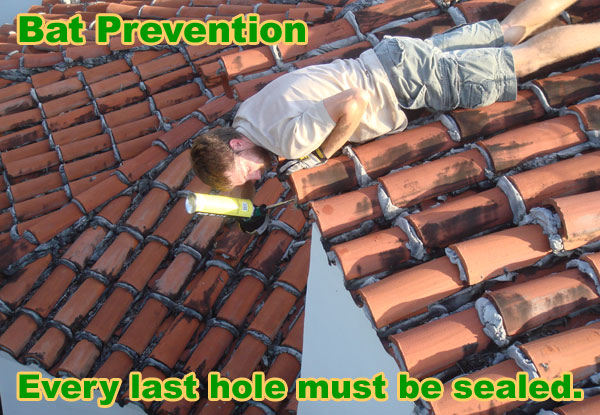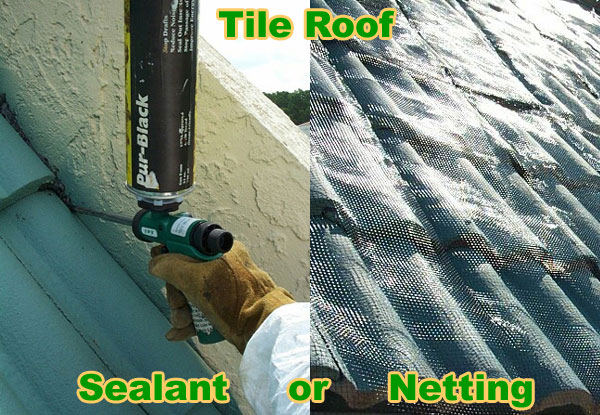
What makes a barrel tile roof so attractive also makes it very difficult to remove bats from. The many ridges of a barrel tile roof look nice, but each tile has gaps under it that bats can squeeze through. Clay tiles are warm and dark, and they make a great place for bats to roost. Bats also prefer entering and exiting through vertical gaps rather than horizontal ones, such as the opening of a chimney. If there is a tear in the tarpaper below the tiles, then the bats can easily take up residence in the attic as well. Because each piece of tile has ridges the bats can enter through, it is very difficult to remove bats from and then seal a barrel tile roof because there are hundreds of entry points.
Diseases They Can Spread
Once the bats have access to your roof, via the tiles, it is almost certain that they will find a way into your attic. If bats get into your attic or living areas, there are several problems that could result. Bats, like all mammals can carry rabies. Although most bats are not carriers, it is possible that a rabid bat could access the living areas of your home and bite you. There is no way to be sure that the bat that bit you is not a carrier, so you would have to undergo medical treatment immediately. Rabies is fatal if left untreated.
The greatest health concern involving bats is due to a fungus that lives in their guano. The spores of the fungus, if inhaled, can cause a lung infection called histoplasmosis. Although histoplasmosis often clears up after a few weeks, it can spread and cause serious harm throughout the body. Because bats produce large amounts of guano due to the fact that they eat up to 50% of their body weight in insects per day, an attic full of guano is a serious health hazard.
Removal
To remove bats legally and humanely, live bat exclusion is performed. This involves placing a one-way exclusion device on the entry point or points. The bats can exit through the device, but they can’t re-enter through it due to a one-way flap or valve. Exclusion devices come in many forms and can be made from several different materials. Some are cone or funnel shaped and made from plastic, and others are made from PVC pipes. Netting can be used as an exclusion device as well. After the exclusion device is in place for a few days and the bats have all exited, then the entry points can be sealed to prevent the bats from entering again.
If the bats are roosting under the tiles and not in an attic, then each ridge could hold bats. Since every ridge is a potential entry point for bats, it would be almost impossible to install an exclusion device on every ridge. The time and cost involved in installing a device on each ridge would be very high. Because it is illegal to kill bats, you can’t just seal up the ridges with the bats still inside them or the attic. For this reason, it is best to wait until the bats have migrated for the winter so that each ridge can be sealed.

Migration And Sealing
Once the bats are gone for the season, you have time to do the job of sealing the entry points correctly. Before sealing the ridges, you should have the roof checked for damage. If bats can get under the tiles, other animals, such as rodents or squirrels, may be also entering. Bats don’t do always do damage other than leaving behind piles of guano, but other animals can cause damage. Fix any damage to tar paper and wood before beginning the sealing process. One way to seal the entire roof at once is to use fine mesh netting that installs over the whole thing. This is not a very attractive fix for your problem, however, as the netting is quite visible. To keep the attractive look of the roof intact while also preventing the bats from returning, each ridge must be sealed individually.
Because each ridge of a barrel tile roof must be sealed individually, it is a time consuming process. The most effective means of sealing the tiles is by installing steel cloth at the bottom of each ridge where the bats enter through. The steel cloth is woven with holes that are smaller than a bat can squeeze through. The weave allows for ventilation and drainage, but the bats can’t get through. The tiles are fitted with a piece of steel cloth, and the pieces are then drilled in. In order to ensure that no bats can enter, each ridge must have the steel cloth attached to it. You should also check other areas of the roof to ensure that there are no damaged areas, cracks, or gaps where the bats could enter. When they return from migration, they will be looking for a way to enter their former roost.
NEED LOCAL HELP? We have wildlife removal professionals servicing 95% of the USA. Click here to hire a local bat removal expert in your home town. Updated 2018. You may also want to read my hiring advice to know what to look for. And before you hire anyone, it's best to be educated on the subject, so browse this site and especially read the bats in the attic home page.
The barrel tile roof is a very creative and beautiful option to adorn your home with. The vast majority of people go with normal shingles to cover the upper exterior to their home, but barrel tile gives such an unusual look that is both attractive and functional in ways that separated from the normal shingle look most often found.

However, this kind of roof can be an attractive location for the bat. You may not have really considered this, but because of the unusual design of the roofing materials, this easily allows a bat to slide itself into the arched area of each of the tiles to create a home for itself.
So, What’s the Big Deal?
This is one of those situations where some people may not look at this is a particularly big issue. So, what if a bat is living in the barrel tile of the roof? Is that really hurting something?
The truth is that it can have considerable consequences for you and your family. Bats are the carriers of a large number of pathogens and diseases, and they are known to leave their waste just about any place they travel. This waste often contains the parasites, which can become airborne is the feces dries. That poses a tremendous risk to you, your family, and your pets, and is a primary reason why so many people want these creatures gone.
So, What to Do About It?
Now that you understand the situation, you are probably asking yourself how you can get rid of the bat? That’s an interesting question because the shape of the barrel tile provides a little bit of a different pathway to be taken to exclude these animals.
The first thing to understand before taking any kind of action, is that you need to do all that you can to protect yourself. Before even attempting to remove the bat you need to make sure that all of your exposed skin is covered. This includes the wearing of gloves, goggles, and a surgical mask to prevent the parasites from being able to enter your respiratory canal.
Once you are properly adorned to protect yourself the next step is to place a one-way exclusion device at the entry point of where they are getting into the barrel tile. What this device does is give the bat the ability to exit through the funnel, but they are not able to reenter because of the way that the flapper valve is created. This is why it is considered a one-way device.
These kinds of devices come in several different shapes, including like cones or funnels. They are often made from PVC pipes, which provide a great deal of durability and strength to keep the bat from being able to escape.
Once you have placed the exclusion device in position your next step is to just wait it out. In a matter of a day or two the bat will need to head out to hunt for food and once it is gone it will not be able to get back in. Your problem is resolved at that point.
Now, all you need to do is seal the area where the bat was gaining access into your barrel tile to ensure that they don’t get back in again. With a minimal amount of work you were able to get rid of your back problem and exclude them from being able to return again.
You should be aware that the bats could be roosting under more than one tile, meaning you may need to place the exclusion device in several locations before your problem is resolved.
Wildlife Education - Information and Advice for the Safe Removal of Bats from Attics
Copyright 2018 - batsintheattic.org - Site Map - Please be kind to bats! They are valuable animals, not aggressive, and they are vulnerable!